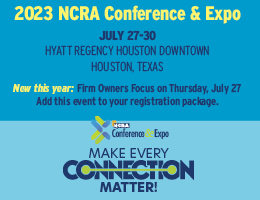Once a transcript is out of a court reporter’s hands, it’s up to the agency’s production staff to get it to the client. Peggy Nelson of Paradigm Reporting & Captioning in Minneapolis, Minn., and Angie Hibbert of First Choice Reporting & Video in Miami, Fla., share the following tips to make the final stages of transcript production as smooth as possible. As with most work relationships, communication is key to making everyone look good, including the clients.
- When filling out any paperwork or forms by hand, take the necessary time to ensure your handwriting is legible. Anything questionable requires production to have to stop and reach out to the reporter for clarification.
- Always put the job number and date the job was taken on all communication with the agency.
- Exhibit stickers need to be filled out completely and correctly.
- When shipping exhibits back to the agency, always send the appropriate paperwork along with the exhibits. When exhibits arrive without paperwork, it creates a great deal of extra work for the production team trying to match the exhibits with the job.
- If exhibits were retained by counsel and not given to the court reporter, be sure to indicate on your paperwork which attorney took possession of the exhibits.
- If your protocol is to ship exhibits using your own FedEx or UPS account, be sure to provide the account information on the paperwork versus making production call you to get it.
- When using transcript order forms, if the client simply signs their name and doesn’t fill out the rest of the form, please do so for them so that the form is complete when sent into the agency.
- If your job turns into an expedite, communicate this to the agency right away, telling them when the client needs it in their hands and when you anticipate it will be ready to send to the agency for production. Never simply send a rush job into the agency without having forewarned staff. This is a recipe for disaster.
- When a client has requested a specific date and time for delivery (or you have promised one to them) be sure to be clear as to whether a Tuesday delivery means they want it in their hands by 8 a.m. on Tuesday or by end of business day on Tuesday … or if they don’t care as long as they get it on Tuesday. One of the most common issues production rooms deal with is lack of communication around delivery expectations. This results in calls to the agency asking, “Where is my transcript? The reporter said I’d have it on Tuesday.”
- Agencies vary in terms of protocols around rough drafts. Some allow the reporter to email them directly to the client just as soon as it’s available, and others require you to email the agency to allow the agency to send it directly to the client. Make sure you know the protocol for the agency you’re working for that day.
- When attorneys ask that something be marked “confidential” or “Attorneys Eyes Only,” make sure you let the agency know which attorney made this request. Also, find out how they want you to handle this on your end of the transcript creation. Is there a certain protocol already in place on this case or with this client? Do they expect you to do something special with the file? Will the agency be handling everything on their end?
- We love it when we get not just the attorney’s directory information but their email address as well as the name and email address of their legal assistant or paralegal. Not only have we found that those are the folks who really know what format the transcript should be delivered in, we’ve discovered that if we copy them in on the electronic invoice, we get paid much quicker than if we just send the invoice to the attorney.
- While it could vary from agency to agency (which is why it’s imperative to read the paperwork carefully), most agencies prefer a page-image ASCII file to a PTX file. (Be sure the ASCII includes page breaks.)
- Be sure to include a signed certificate page as a pdf when turning in your job.
- One of the biggest delays we encounter in production is waiting on the invoice long after the reporter has sent in the file. Please send both the file and invoice simultaneously whenever possible. We cannot process COD orders without your invoice.
- Reading & Signing: Tell us every time, for every witness. One of the biggest inefficiencies in our production room is trying to figure this out based on how the paperwork is (or isn’t) filled out.
- Take your time when turning in a job to make sure everything is turned in correctly.
- If a witness fails to appear or for any reason the job doesn’t go and you decide not to charge the client, be sure to notify the production department of these facts. Otherwise, it looks like they are waiting on late work, or we worry that the file got lost in spam.
- Any special instructions need to be communicated to the office.
- Please sign your email! We receive tons without signatures, making it hard to know who “stenostar555” is.
Jan Ballman, RPR, CMRS, owner of Paradigm Reporting & Captioning in Minneapolis, Minn., and NCRA Director Rick Levy, RPR, owner of First Choice Reporting & Video in Miami Fla., reached out to their respective production room managers on behalf of the New Professionals Committee.








